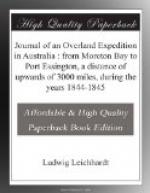My first object was to find good water, and our sable friends guided us with the greatest care, pointing out to us the most shady road, to some wells surrounded with ferns, which were situated in some tea-tree hollows at the confines of the plains and the forest. These wells, however, were so small that our horses could not approach to drink, so that we had to go to another set of wells; where I was obliged to stop, as one of our horses refused to go any farther. This place was about four miles E.N.E. from our last camp. The wells were about six or eight feet deep, and dug through a sandy clay to a stiff bed of clay, on which the water collected. It would appear that the stiff clay of the plains had been covered by the sandy detritus of the ridges, from which the water slowly drained to the wells. It was evident, from the pains which the natives had taken in digging them, that the supply of fresh water was very precarious. In many instances, however, I observed that they had been induced to do so, simply by the want of surface water in the immediate neighbourhood of places where they obtained their principal supply of food. This was particularly the case near the sea-coast, where no surface water is found; whilst the various fish, and even vegetable productions, attract the natives, who will, in such a case, even contract the habit of going the longest possible time without water, or, at least, with very little, as is well shown in Mr. Eyre’s journey round the Australian Bight. We had to water our horses and the bullock with the stew pot; and had to hobble the latter, to prevent his straying, and attacking the natives.
The natives were remarkably kind and attentive, and offered us the rind of the rose-coloured Eugenia apple, the cabbage of the Seaforthia palm, a fruit which I did not know, and the nut-like swelling of the rhizoma of either a grass or a sedge. The last had a sweet taste, was very mealy and nourishing, and the best article of the food of the natives we had yet tasted. They called it “Allamurr” (the natives of Port Essington, “Murnatt"), and were extremely fond of it. The plant grew in depressions of the plains, where the boys and young men were occupied the whole day in digging for it. The women went in search of other food; either to the sea-coast to collect shell-fish,—and many were the broad paths which led across the plains from the forest land to the salt-water—or to the brushes to gather the fruits of the season, and the cabbage of the palms. The men armed with




